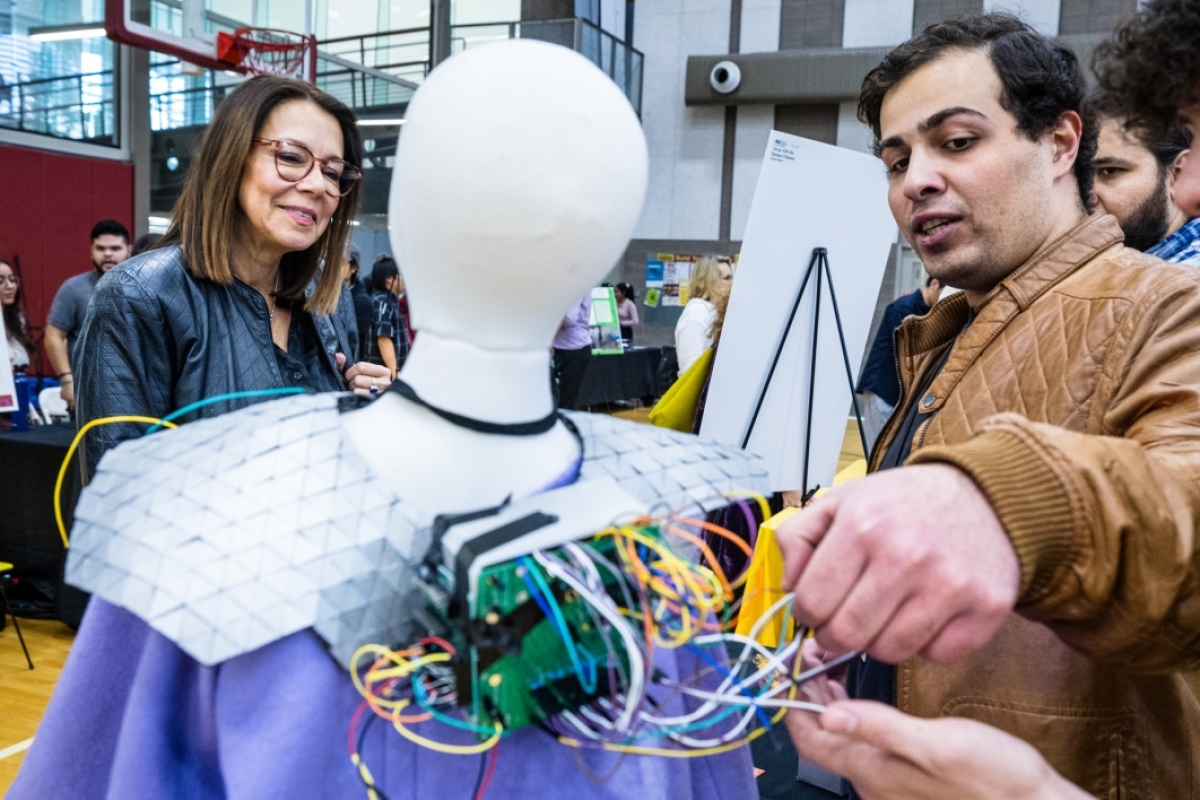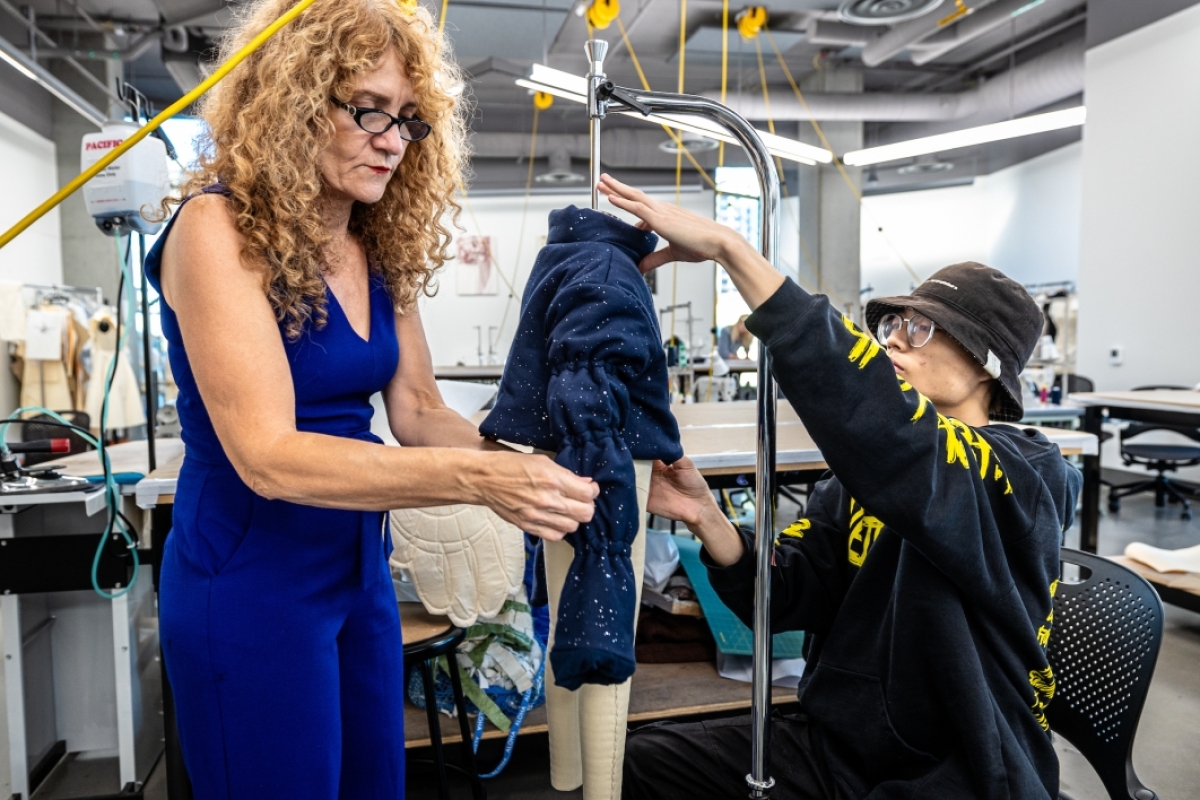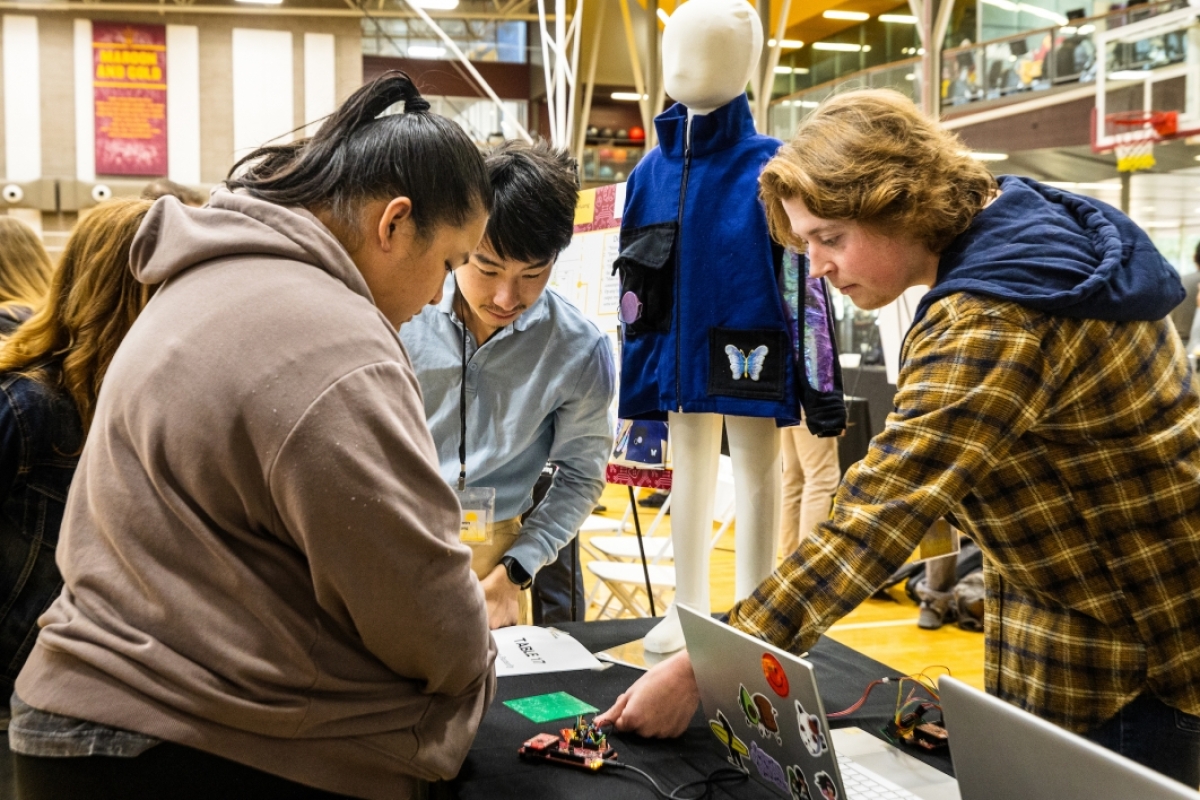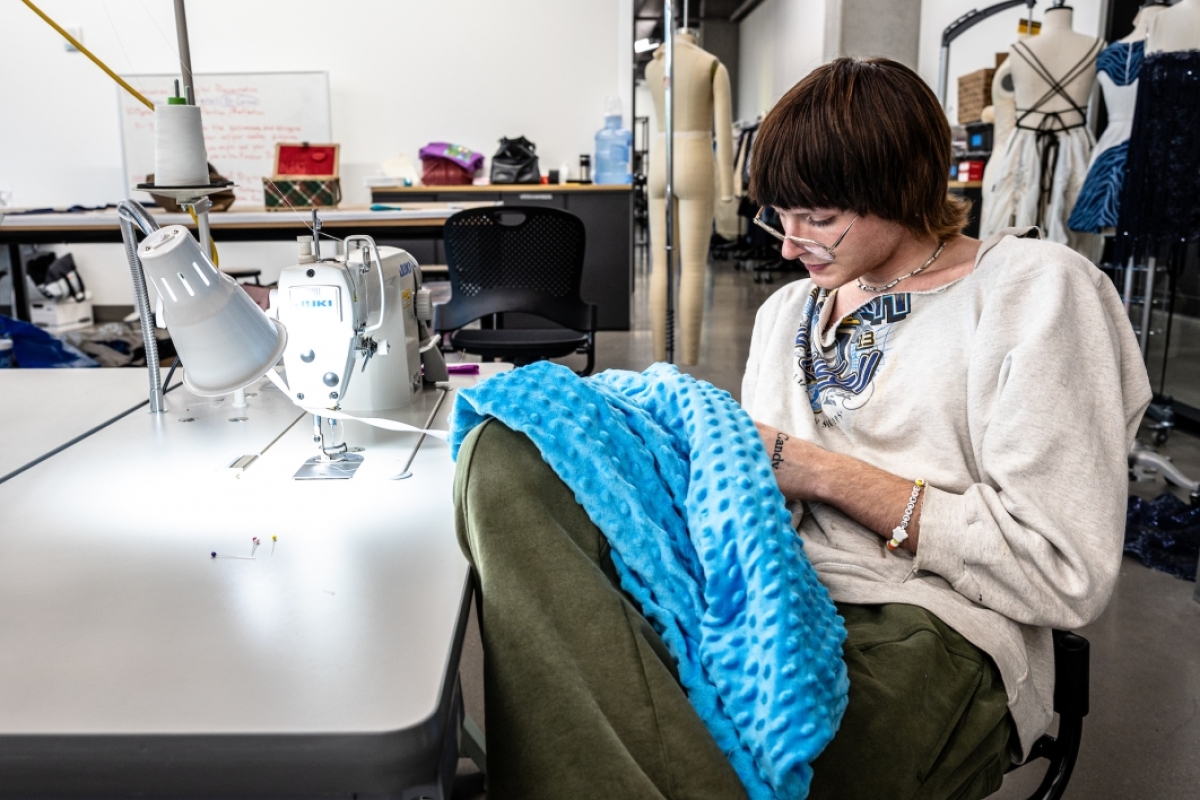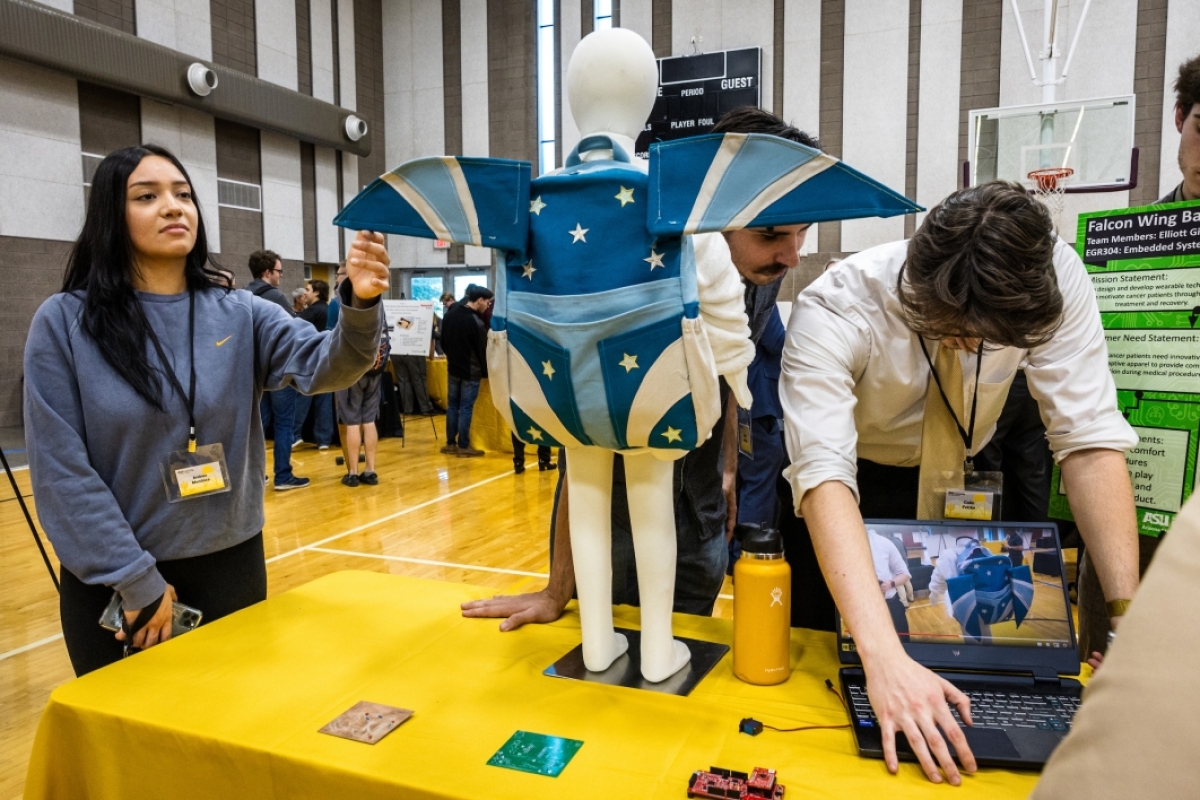Students collaborate on wearable tech for hospitalized children
Created by fashion and engineering students, clothes integrate technology that can help kids in chemotherapy

Third-year robotics and entrepreneurship student Damien D'Amato demonstrates the bubble-blowing mechanism on his Bubble Blaster 6,000 design at the Innovation Showcase on Friday, Dec. 1, at the Polytechnic campus' Sun Devil Fitness Center. Photo by Charlie Leight/ASU News
When kids get sick and are hospitalized, it can be scary and isolating. The constant prodding is painful and intrusive. And often, the rooms are kept very cold.
A group of Arizona State University students collaborated across disciplines and campuses this semester on ways to make those kids feel a little bit better.
Their final designs are soft, warm, beeping, musical, glittery, funny and bubbly.
Some of the students were in EGR 304, Embedded Systems Design, based at the Polytechnic campus, and the rest were in FSN 394, Fashion Design and Wearable Technology, based at the Downtown Phoenix campus.
The engineering students had to come up with technology to help the kids that could be integrated into garments, which were designed by the fashion students with the purpose of accommodating the technology.
The engineers created devices to calm the kids, monitor their health signs, make them laugh and distract them. The fashion designers created garments that were soft, warm and adaptable to medical treatment.
Last year, Shawn Jordan, an associate professor of engineering at The Polytechnic School, co-taught the wearable technology fashion class with Galina Mihaleva, an associate professor at ASU FIDM, the fashion school. That experience led to the collaboration this year.
Jordan said that engineering and fashion students have very different cultures.
“The students are completely different in how they approach design,” he said.
“For the engineers, fashion is packaging. And for the fashion students, the technology is a way of communicating the overarching idea.
“Sometimes with the engineers, the easy place to go is, ‘Let me make a watch or a wristband.’ So a mentoring piece on my end has been, ‘OK, that’s not interesting from a fashion perspective.’
“They have to give the fashion students flexibility to take the tech they’re designing and expand it so it’s not just a wristband but integrated into a garment.”
Mihaleva had previously worked on the Power Play project, in which fashion students designed superhero costumes for patients at Phoenix Children’s Hospital. But she was interested in having her students create wearable technology that provided more long-term benefits.
After searching for a partner, Mihaleva connected with Amanda Hope Rainbow Angels, a Phoenix-based nonprofit that supports children in treatment with adaptive garments, family support, events and financial aid. The organization supported the class project financially, and the Infineon Corp. donated technology kits.
Amanda Hope Rainbow Angels also arranged for the students to tour its downtown Phoenix facility and interview children who were undergoing treatment for cancer.
“We told the students that their clients are children and they need to design something that can comfort them during or after chemotherapy,” Mihaleva said.
“For this class I wanted the students to use empathy. The feedback they got was wonderful.”
During the semester, there were logistical challenges as the students communicated by text, Zoom and email with their counterparts on the other campus. Essentially, they worked on parallel tracks with the goal of integrating the two parts at the end. The 21 teams presented their projects twice at the end of the semester, once at the Downtown Phoenix campus and once at the Polytechnic campus.
One project was called the Bubble Blaster 6,000 and included a light blue jacket made of bubbly-textured soft fabric and a device that blows bubbles, meant to distract a distressed child.
The jacket, created by third-year fashion major Casey Stewart, featured iridescent bubble decorations and was a wrap design to provide easy access to the chemotherapy port that is implanted in the chest of a child undergoing treatment.
“Our goal was to make something fun and comfy that can be used in a hospital, so we went with something everyone likes — bubbles,”’ said Princess Colon, a robotics major, as she presented her group’s project.
Another team designed a little bomber jacket that plays music from a device controlled by a phone app. The fashion student, Jianbang Xu, made the garment of dark blue fleece embedded with sparkles.
“We wanted something that is very special, so we went with a space aesthetic,” said Sean Vellequette, a robotics major.
“One of the things we noticed when we toured Amanda Hope is that there are a lot of arts and crafts but nothing that satisfies a music requirement, and we thought that was an untapped medium.”
“Because the treatment can take hours and they have to sit still, this gives them another stimulus other than drawing,” said Ethan Conner, also a robotics major.
The students learned that kids in treatment often feel out of control as doctors and nurses continuously prod them. So one team developed a little robot avatar that the child can move. The robot controller was integrated into a green velvet robe that gives "Baby Yoda" vibes.
The technology was a challenge, according to Raj Kodithyala, a robotics major.
“We had guidance controlling a device with our phones, but this project entailed communicating two of these micro Bluetooth chips, and that was new territory for us and we needed supplemental material and a lot of reading,” he said. “We went above and beyond.”
The Mindful Butterfly was a colorful jacket with butterfly wings that measures the child’s heart rate. If the heart rate is too high, it activates a little butterfly on the child’s wrist and the child can breathe along with the flapping wings to slow their breath rate and calm themselves. A speaker system plays calming music, and LED lights in the sleeve light up red if the heart rate is too high.
Lizbeth Vigueria-Ramirez, a fashion major, designed the Mindful Butterfly jacket and said that all of the students, both engineering and fashion, are designers.
“We’re all stubborn about our own ideas,” she said. “So there was bit of butting heads on which direction we wanted to go. But in the end, we came to a resolution, and it was interesting because as I worked on mine and explained it to them, they also explained to me how their components were working, and it was interesting to see how they would mesh together.”
She was inspired to use butterflies because the Amanda Hope facility has a butterfly motif and she liked the idea of metamorphosis for a child in treatment.
“I’m really proud of how it turned out,” she said.
Lorraine Tallman, founder of Amanda Hope Rainbow Angels, was impressed by the projects at the presentation. Amanda Hope was her daughter, who died in 2012 after battling leukemia and then a brain tumor. Tallman founded the organization that same year.
While undergoing treatment, Amanda Hope longed for apparel that could accommodate chemo ports, feeding tubes and other medical paraphernalia. So the organization now offers more than 60 designs of adaptive garments.
Tallman was happy to collaborate with the ASU students and bring them to the center.
“What kind of fabric works? What kind of zippers? It became a beautiful collaboration between fashion, the engineers and our patients,” she said.
“It’s been amazing to see the students creatively think and problem-solve and know from a child’s perspective what would help them.”
The plan is to donate the completed projects to the Amanda Hope Rainbow Angels facility, Jordan said. So the students needed to make sure they were designing for a range of children.
Tallman said the project will make a big difference.
“Hospitalized children can feel isolated,” she said.
“The other children move on in life. Families move on in life. Students go to prom, and they don’t get to. All life continues on but not for them.
“So when anything comes to them in the bed where they are, they remember that people are thinking of them, and it’s so powerful.”
More Science and technology

The science behind chronic stress
Stress comes in many shapes and sizes. There’s the everyday stress of preparing for a final exam or being stuck in traffic. And the more significant stress of losing a friend, family member,…

ASU planetary scientist to be inducted into the National Academy of Sciences
The National Academy of Sciences is inducting School of Earth and Space Exploration Director Meenakshi Wadhwa into the 2023 class of new members for her pioneering work in planetary sciences and…

Unlocking the potential of AI for homeland security
“Can we do what we're doing now cheaper, more efficiently, more effectively?” Adam Cox, director in the Office of Strategy and Policy at the Department of Homeland Security Science and Technology…
